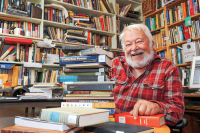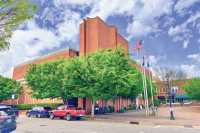HAM radio holds on in a high tech world
The term HAM radio doesn’t usually conjure visions of a chic hi-tech world, but usually something closer to, as Al Sanders put it, “a bunch of old gray headed guys talking on the radio.”
Sanders heads up a Haywood group of a few dozen hams, as they call themselves, who spend their free time tinkering and talking on amateur radio.
But, Sanders notes, the gray heads aren’t ruling the day in amateur radio anymore. The hobby has, indeed, gone hi-tech.
“If you can get the younger folks engaged, then they really do get turned on by it,” said Sanders. “So many of the HAM radio hobbyists clubs are dying because they don’t get involved with the younger people.”
But these days, there’s plenty to entice a younger, digitally native crowd. Computers, said Sanders, are an integral part of the hobby for some enthusiasts, and there are a multitude of apps for nearly every species of smart phone that will connect you to a HAM frequency.
And that can connect you with people in just about every corner of the world.
Related Items
Gary Dahlhofer, another member of the Haywood County Amateur Radio Club, just chatted last week with a guy on an island near Portugal, and then with a friend in Florida. Just before that he connected with a user in Switzerland. All without a long-distance charge or dock to his cell minutes.
At its essence, the hams were the first truly global social network, making connections with other radio users across the globe long before the Internet was a common term.
To be a ham, you have to get licensed by the Federal Communications Commission, though that’s not as hard as it once was, said Dahlhofer. There’s no more Morse code to memorize.
Once the test is passed, it gives you access to a range of radio frequencies, which means all you need is a radio and antenna to get started talking to someone across the street or across the world.
For many hams, it’s that social aspect that keeps them enamored of the radios. For others, like Sanders, it’s knowing why and how it all works.
“Most people don’t have a clue what makes a cell phone work and what makes an email work, but with HAM radio, you can get in and understand your equipment,” said Sanders. He was the kind of kid who would rather take apart his toys than play with them, so HAM radio was a natural fit for him.
And that’s another selling point of HAM radio — it’s not reliant on infrastructure like cell phones and emails, which makes it not only an interesting hobby but a potentially life-saving one.
If a massive event, such as a tornado or landslide, knocks out cell towers and traditional radio communications, the hams can be up and running.
“What the hams can do is assist them [emergency personnel] in communication when a major incident happens,” said Dahlhofer, which is why half of their club is certified by the Federal Emergency Management Agency to help out on such occasions.
Right now, the club is trying to take it a step further, raising money to buy handheld GPS units that operate on HAM frequencies (they’re handheld size). In a catastrophe, emergency workers outfitted with them could still be tracked on their rescue or recovery missions, whereas conventional GPS units would be reliant on infrastructure to work.
They could even be used for less calamitous events like the annual Blue Ridge Breakaway, tracking which riders are where.
The Breakaway is a cycling race, now in its second year, held on scenic roads sponsored by the Haywood County Chamber of Commerce. Since there isn’t cell reception on the whole race route, particularly on the Blue Ridge Parkway portion, hams were integral to keeping the race safe.
Hams rode motorcycles along behind the cyclists, relaying their locations back to central HAM operators. With the new GPS equipment, they could keep track of riders throughout the pack with ease.
The Haywood County Chamber of Commerce, which sponsors the race, has already pitched in to help pay for the tools.
They’re trying to come up with $2,000 for the devices, which cost $260 each, and they’re seeking tax-deductible donations from the community to help out.
From simple socializing to community safety, HAM radio has many applications, and you don’t have to be a techie to fall in love with the tech, said Dahlhofer.
“I’m an investment banker with a marketing degree,” he said. “I think my interest in HAM radio at that level was to talk to other people around the world. It’s just fun making contacts with different people.”
Learn more:
What: HAM Radio Field DayWhere: State Employees Credit Union, Clyde
When: 9 a.m. Saturday, June 25 until 3 p.m. Sunday, June 26









